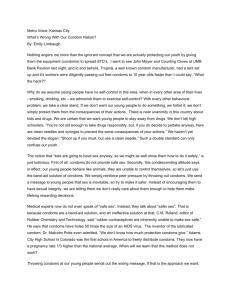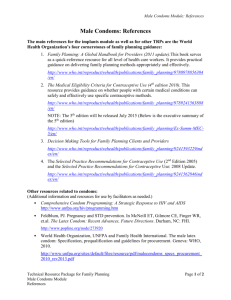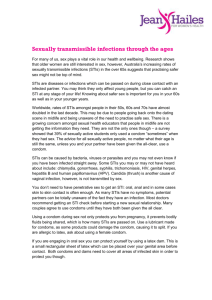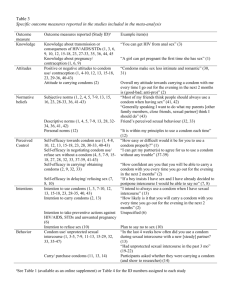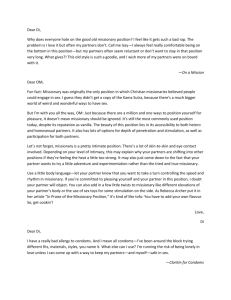Female Condoms
advertisement
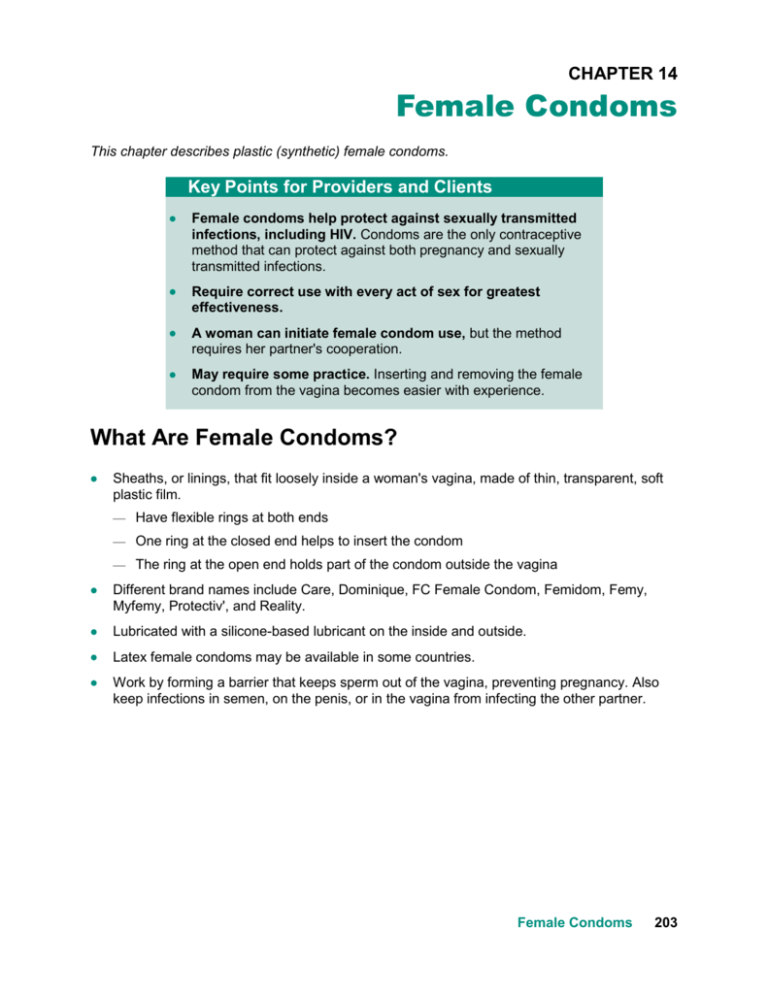
CHAPTER 14 Female Condoms This chapter describes plastic (synthetic) female condoms. Key Points for Providers and Clients Female condoms help protect against sexually transmitted infections, including HIV. Condoms are the only contraceptive method that can protect against both pregnancy and sexually transmitted infections. Require correct use with every act of sex for greatest effectiveness. A woman can initiate female condom use, but the method requires her partner's cooperation. May require some practice. Inserting and removing the female condom from the vagina becomes easier with experience. What Are Female Condoms? Sheaths, or linings, that fit loosely inside a woman's vagina, made of thin, transparent, soft plastic film. — Have flexible rings at both ends — One ring at the closed end helps to insert the condom — The ring at the open end holds part of the condom outside the vagina Different brand names include Care, Dominique, FC Female Condom, Femidom, Femy, Myfemy, Protectiv', and Reality. Lubricated with a silicone-based lubricant on the inside and outside. Latex female condoms may be available in some countries. Work by forming a barrier that keeps sperm out of the vagina, preventing pregnancy. Also keep infections in semen, on the penis, or in the vagina from infecting the other partner. Female Condoms 203 How Effective? Effectiveness depends on the user: Risk of pregnancy or sexually transmitted infection (STI) is greatest when female condoms are not used with every act of sex. Few pregnancies or infections occur due to incorrect use, slips, or breaks. Protection against pregnancy: As commonly used, about 21 pregnancies per 100 women using female condoms over the first year. This means that 79 of every 100 women using female condoms will not become pregnant. When used correctly with every act of sex, about 5 pregnancies per 100 women using female condoms over the first year. Return of fertility after use of female condom is stopped: No delay Protection against HIV and other STIs: Female condoms reduce the risk of infection with STIs, including HIV, when used correctly with every act of sex. Why Some Women Say They Like Female Condoms Women can initiate their use Have a soft, moist texture that feels more natural than male latex condoms during sex Help protect against both pregnancy and STIs, including HIV Outer ring provides added sexual stimulation for some women Can be used without seeing a health care provider Why Some Men Say They Like Female Condoms 204 Can be inserted ahead of time so do not interrupt sex Are not tight or constricting like male condoms Do not dull the sensation of sex like male condoms Do not have to be removed immediately after ejaculation Family Planning: A Global Handbook for Providers Side Effects, Health Benefits, and Health Risks Side Effects None Known Health Benefits Known Health Risks Help protect against: None Risks of pregnancy STIs, including HIV Correcting Misunderstandings (see also Questions and Answers) Female condoms: Cannot get lost in the woman's body. Are not difficult to use, but correct use needs to be learned. Do not have holes that HIV can pass through. Are used by married couples. They are not only for use outside marriage. Do not cause illness in a woman because they prevent semen or sperm from entering her body. Female Condoms 205 Who Can Use Female Condoms Medical Eligibility Criteria for Female Condoms All women can use plastic female condoms. No medical conditions prevent the use of this method. (For information on eligibility criteria for latex female condoms, see Medical Eligibility Criteria for Male Condoms. For information on managing clients with latex allergy, see Male Condoms, Mild irritation in or around the vagina and penis or mild allergic reaction to condom; and Severe allergic reaction to condom.) Providing Female Condoms When to Start Any time the client wants. Explaining How to Use IMPORTANT: Whenever possible, show the client how to insert the female condom. Use a model or picture, if available, or your hands to demonstrate. You can create an opening similar to a vagina with one hand and show how to insert the female condom with the other hand. Explain the 5 Basic Steps of Using a Female Condom Basic Steps 1. Use a new female condom for each act of sex Important Details Check the condom package. Do not use if torn or damaged. Avoid using a condom past the expiration date—do so only if newer condoms are not available. If possible, wash your hands with mild soap and clean water before inserting the condom. 206 Family Planning: A Global Handbook for Providers 2. Before any physical contact, insert the condom into the vagina Can be inserted up to 8 hours before sex. For the most protection, insert the condom before the penis comes in contact with the vagina. Choose a position that is comfortable for insertion—squat, raise one leg, sit, or lie down. Rub the sides of the female condom together to spread the lubricant evenly. Grasp the ring at the closed end, and squeeze it so it becomes long and narrow. With the other hand, separate the outer lips (labia) and locate the opening of the vagina. Gently push the inner ring into the vagina as far up as it will go. Insert a finger into the condom to push it into place. About 2 to 3 centimeters of the condom and the outer ring remain outside the vagina. 3. Ensure that the penis enters the condom and stays inside the condom The man or woman should carefully guide the tip of his penis inside the condom—not between the condom and the wall of the vagina. If his penis goes outside the condom, withdraw and try again. If the condom is accidentally pulled out of the vagina or pushed into it during sex, put the condom back in place. 4. After the man withdraws his penis, hold the outer ring of the condom, twist to seal in fluids, and gently pull it out of the vagina The female condom does not need to be removed immediately after sex. Remove the condom before standing up, to avoid spilling semen. If the couple has sex again, they should use a new condom. Reuse of female condoms is not recommended (see Question 5). Female Condoms 207 5. Dispose of the used condom safely Wrap the condom in its package and put it in the rubbish or latrine. Do not put the condom into a flush toilet, as it can cause problems with plumbing. Supporting the User Ensure client understands correct use Ask the client to explain the 5 basic steps of using the female condom while handling one. If a model is available, the client can practice inserting the condom in the model and then taking it out. Ask the client how many condoms she thinks she will need until she can return Give plenty of condoms and, if available, lubricant. Explain why using a condom with every act of sex is important Just one unprotected act of sex can lead to pregnancy or Tell the client where she can buy female condoms, if needed. STI—or both. If a condom is not used for one act of sex, try to use one the next time. A mistake once or twice does not mean that it is pointless to use condoms in the future. Explain about emergency contraceptive pills (ECPs) Explain ECP use in case of errors in condom use—including Discuss ways to talk about using condoms Discuss skills and techniques for negotiating condom use 208 not using a condom—to help prevent pregnancy (see Emergency Contraceptive Pills). Give ECPs, if available. with partners (see Bringing Up Condom Use). Family Planning: A Global Handbook for Providers Lubricants for Female Condoms Plastic female condoms come lubricated with a silicone-based lubricant. Unlike most male condoms, which are made of latex, plastic condoms can be used with any type of lubricant—whether made with water, silicone, or oil. Some female condoms come with additional lubricant in the package. Some clinics may be able to provide clients with more lubricant. If a client needs additional lubrication, she can also use clean water, saliva, any oil or lotion, or a lubricant made of glycerine or silicone. Tips for New Users Suggest to a new user that she practice putting in and taking out the condom before the next time she has sex. Reassure her that correct use becomes easier with practice. A woman may need to use the female condom several times before she is comfortable with it. Suggest she try different positions to see which way insertion is easiest for her. The female condom is slippery. Some women find insertion easier if they put it in slowly, especially the first few times. If a client is switching from another method to the female condom, suggest that she continue with the previous method until she can use the female condom with confidence. "Come Back Any Time": Reasons to Return Assure every client that she is welcome to come back any time—for example, if she has problems, questions, or wants another method; she has any major change in health status; or she thinks she might be pregnant. Also if: She has difficulty using female condoms correctly or every time she has sex. She recently had unprotected sex and wants to avoid pregnancy. She may be able to use ECPs (see Emergency Contraceptive Pills). Helping Continuing Users 1. Ask how the client is doing with the method and whether she is satisfied. Ask if she has any questions or anything to discuss. 2. Ask especially if she has any trouble using female condoms correctly and every time she has sex. Give her any information or help that she needs (see Managing Any Problems). 3. Give her more female condoms and encourage her to come back for more before her supply runs out. Remind her where else she can obtain female condoms. 4. Ask a long-term client about major life changes that may affect her needs—particularly plans for having children and STI/HIV risk. Follow up as needed. Female Condoms 209 Managing Any Problems Problems With Use May or may not be due to the method. Problems with condoms affect clients' satisfaction and use of the method. They deserve the provider's attention. If the client reports any problems, listen to her concerns and give advice. Offer to help the client choose another method—now, if she wishes, or if problems cannot be overcome—unless condoms are needed for protection from STIs, including HIV. Difficulty inserting the female condom Ask the client how she inserts a female condom. If a model is available, ask her to demonstrate and let her practice with the model. If not, ask her to demonstrate using her hands. Correct any errors. Inner ring uncomfortable or painful Suggest that she reinsert or reposition the condom so that the inner ring is tucked back behind the pubic bone and out of the way. Condom squeaks or makes noise during sex Suggest adding more lubricant to the inside of the condom or onto the penis. Condom slips, is not used, or is used incorrectly ECPs can help prevent pregnancy (see Emergency Contraceptive Pills). Little can be done to reduce the risk of STIs if a condom breaks, slips, or is not used (see Male Condoms, Question 7). If the client has signs or symptoms of STIs after having unprotected sex, assess or refer. If a client reports slips, she may be inserting the female condom incorrectly. Ask her to show how she is inserting the condom, using a model or demonstrating with her hands. Correct any errors. Difficulty persuading partner to use condoms or not able to use a condom every time Discuss ways to talk with her partner about the importance of condom use for protection from pregnancy and STIs. (See Male Condoms, Difficulty persuading partner to use condoms or not able to use a condom every time.) Mild irritation in or around the vagina or penis (itching, redness, or rash) Usually goes away on its own without treatment. Suggest adding lubricant to the inside of the condom or onto the penis to reduce rubbing that may cause irritation. If symptoms persist, assess and treat for possible vaginal infection or STI, as appropriate. 210 Family Planning: A Global Handbook for Providers If there is no infection, help the client choose another method unless the client is at risk for STIs, including HIV For clients at risk of STIs, including HIV, suggest using male condoms. If using male condoms is not possible, urge continued use of female condoms despite discomfort. If neither partner has an infection, a mutually faithful sexual relationship provides STI protection without requiring condom use but does not protect against pregnancy. Suspected pregnancy Assess for pregnancy. A woman can safely use female condoms during pregnancy for continued STI protection. Female Condoms 211 Questions and Answers About Female Condoms 1. Is the female condom difficult to use? No, but it does require practice and patience. See Tips for New Users. 2. Can female condoms effectively prevent both pregnancy and STIs, including HIV? Yes. Female condoms offer dual protection, against both pregnancy and STIs, including HIV, if used consistently and correctly. Many people, however, do not use condoms every time they have sex, or do not use them correctly. This reduces protection from both pregnancy and STIs. 3. Can a female condom and a male condom be used at the same time? No. Male and female condoms should not be used together. This can cause friction that may lead to slipping or tearing of the condoms. 4. What is the best way to make sure the penis goes into the condom and not outside the condom? To avoid incorrect use, the man should carefully guide his penis and place the tip inside the outer ring of the condom. If the penis goes between the wall of the vagina and the condom, the man should withdraw and try again. 5. Can the female condom be used more than once? Reuse of the female condom is not recommended. Because not enough female condoms are available in some areas, however, and some clients reuse them, the World Health Organization has developed instructions for disinfecting and washing female condoms for reuse. The instructions are being tested for safety and effectiveness. Some programs may introduce instructions for reuse if female condom availability is limited. 6. Can the female condom be used while a woman is having her monthly bleeding? Women can use the female condom during their monthly bleeding. The female condom cannot be used at the same time as a tampon, however. The tampon must be removed before inserting a female condom. 7. Isn't the female condom too big to be comfortable? No. Female condoms are the same length as male condoms, but wider. They are very flexible and fit to the shape of the vagina. Female condoms have been carefully designed and tested to fit any woman, whatever the size of her vagina, and any man, whatever the size of his penis. 8. Can a female condom get lost inside a woman's body? No. The female condom remains in a woman's vagina until she takes it out. It cannot go past a woman's cervix and into the womb (uterus) because it is too large for that. 212 Family Planning: A Global Handbook for Providers 9. Can the female condom be used in different sexual positions? Yes. The female condom can be used in any sexual position. 10. Why are female condoms more expensive than male condoms? Purchased in bulk in 2006, female condoms cost US $0.66 apiece, while male condoms cost only US $0.03 apiece. This is because polyurethane material costs more than latex and because far fewer female condoms are produced. To help reduce cost, a latex female condom has been developed. Purchased in bulk, this new latex female condom can cost as little as US $0.22 per condom. It is expected that programs will buy more of these latex female condoms and distribute them more widely once they are available. Female Condoms 213

